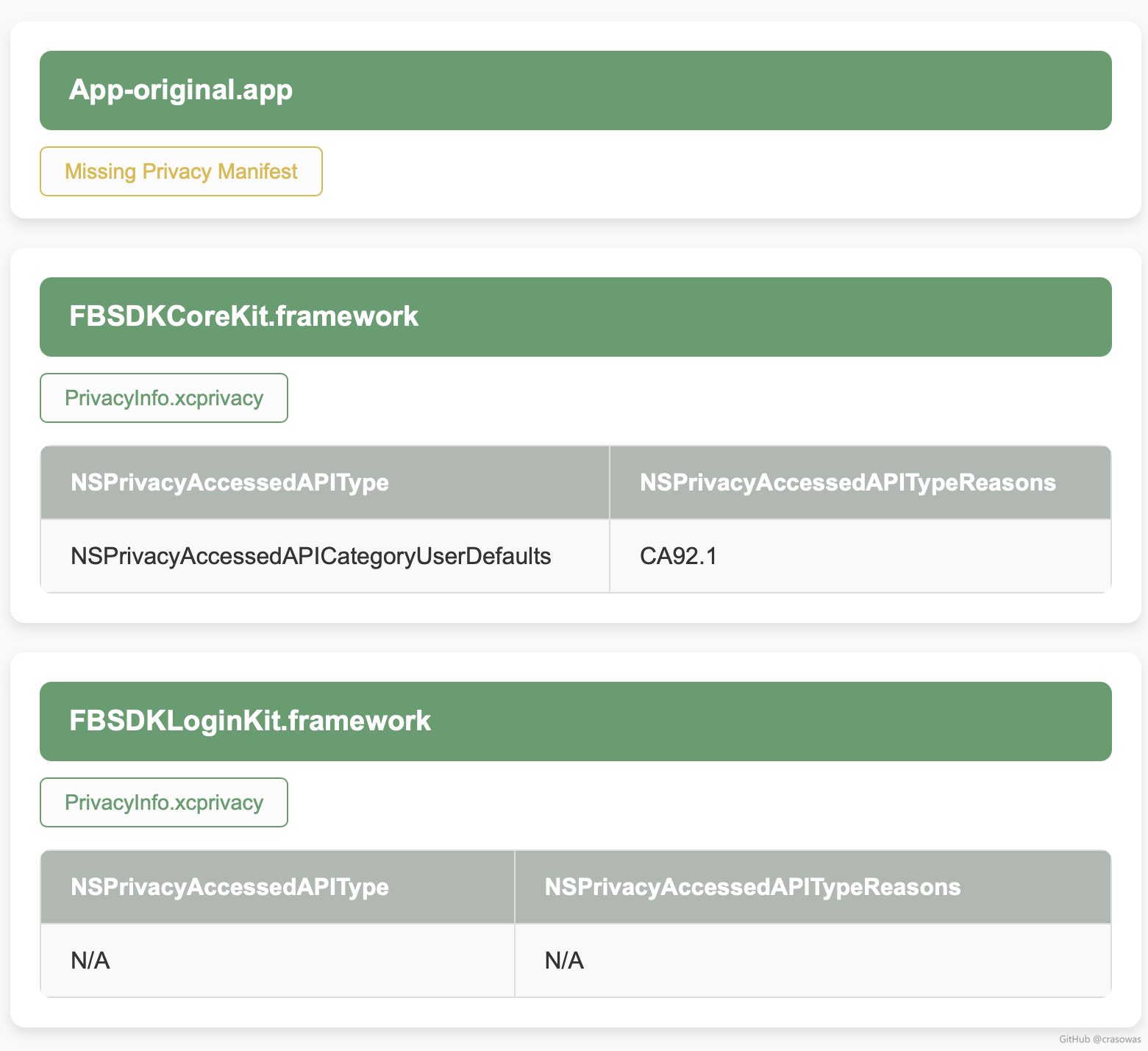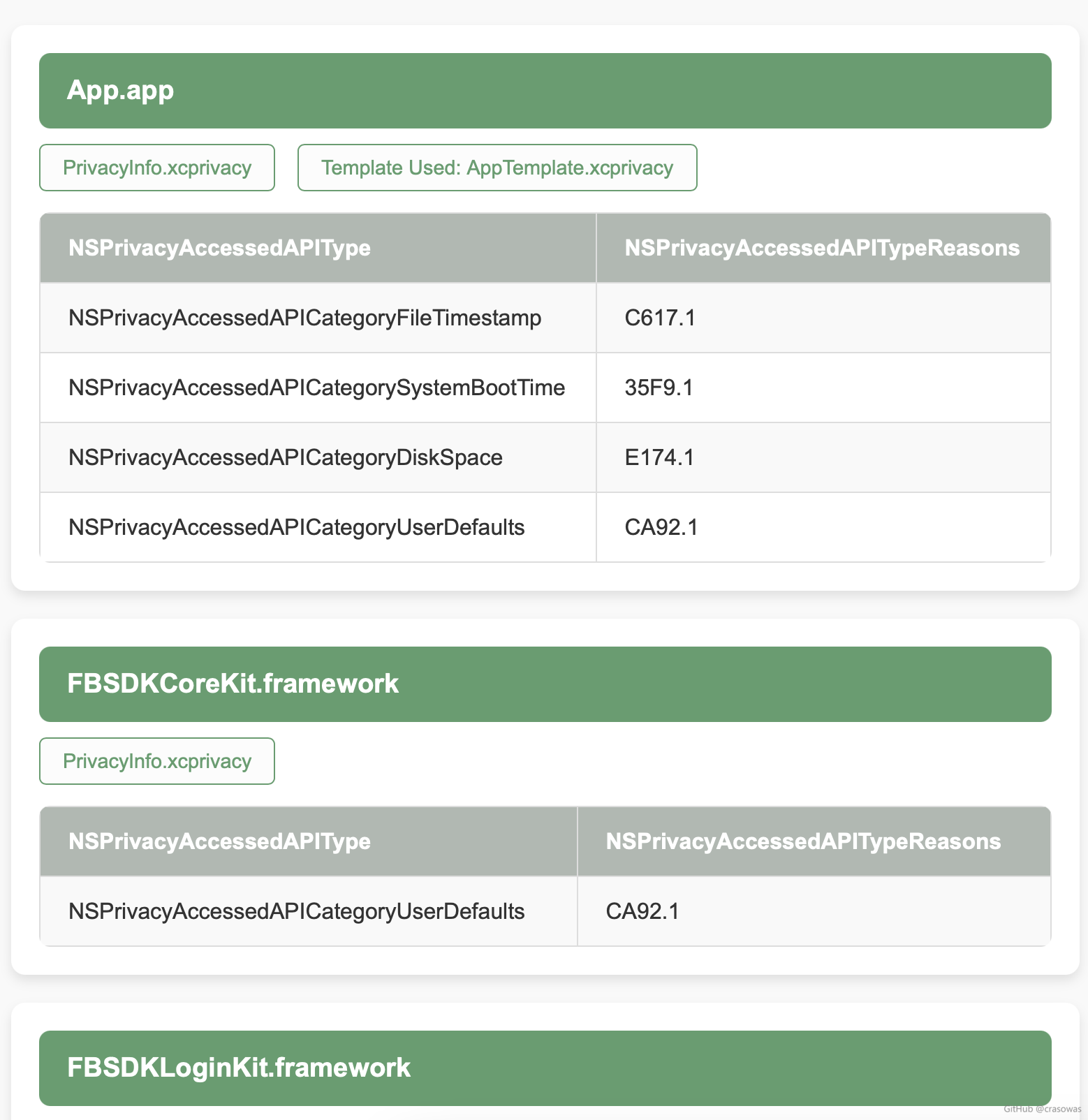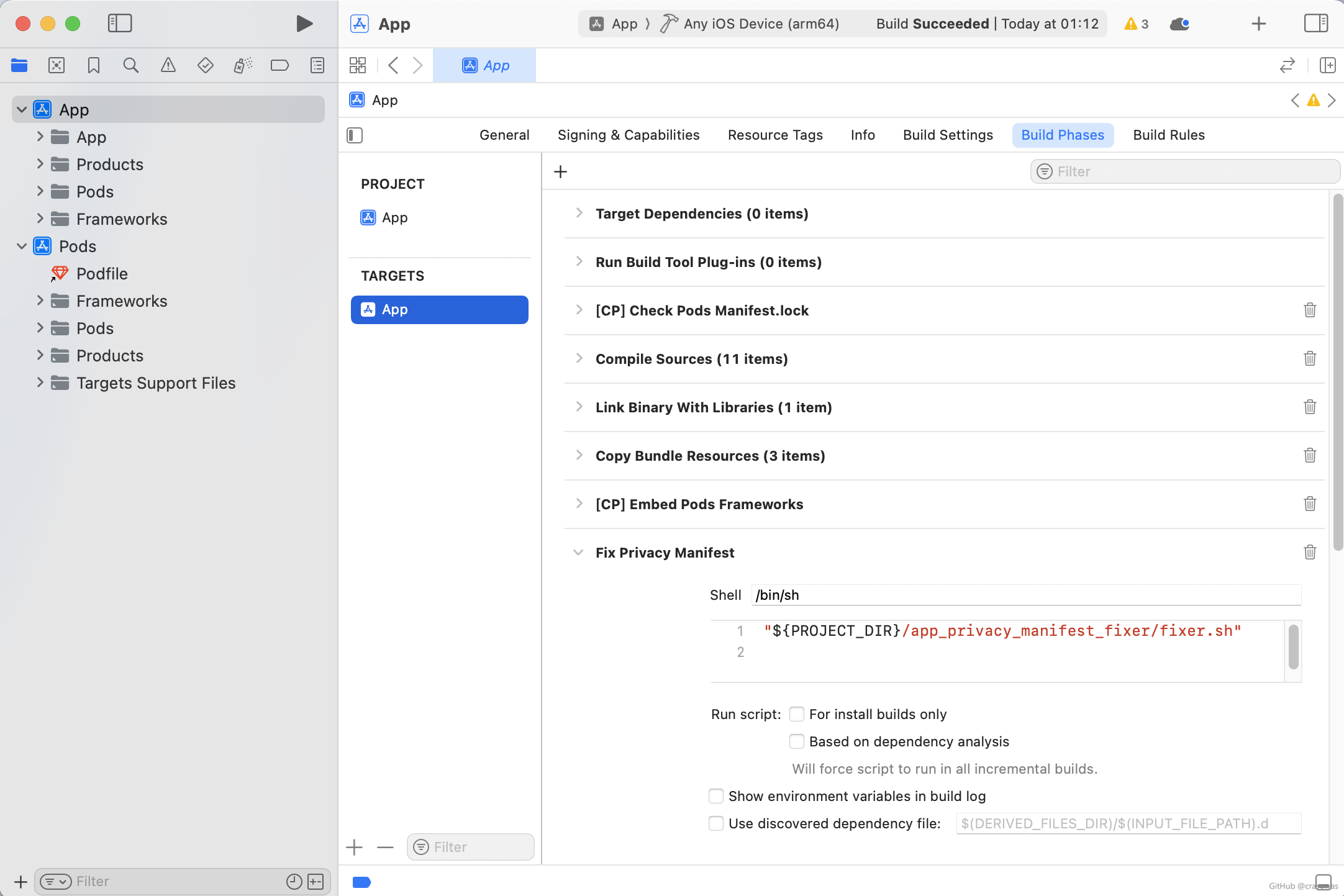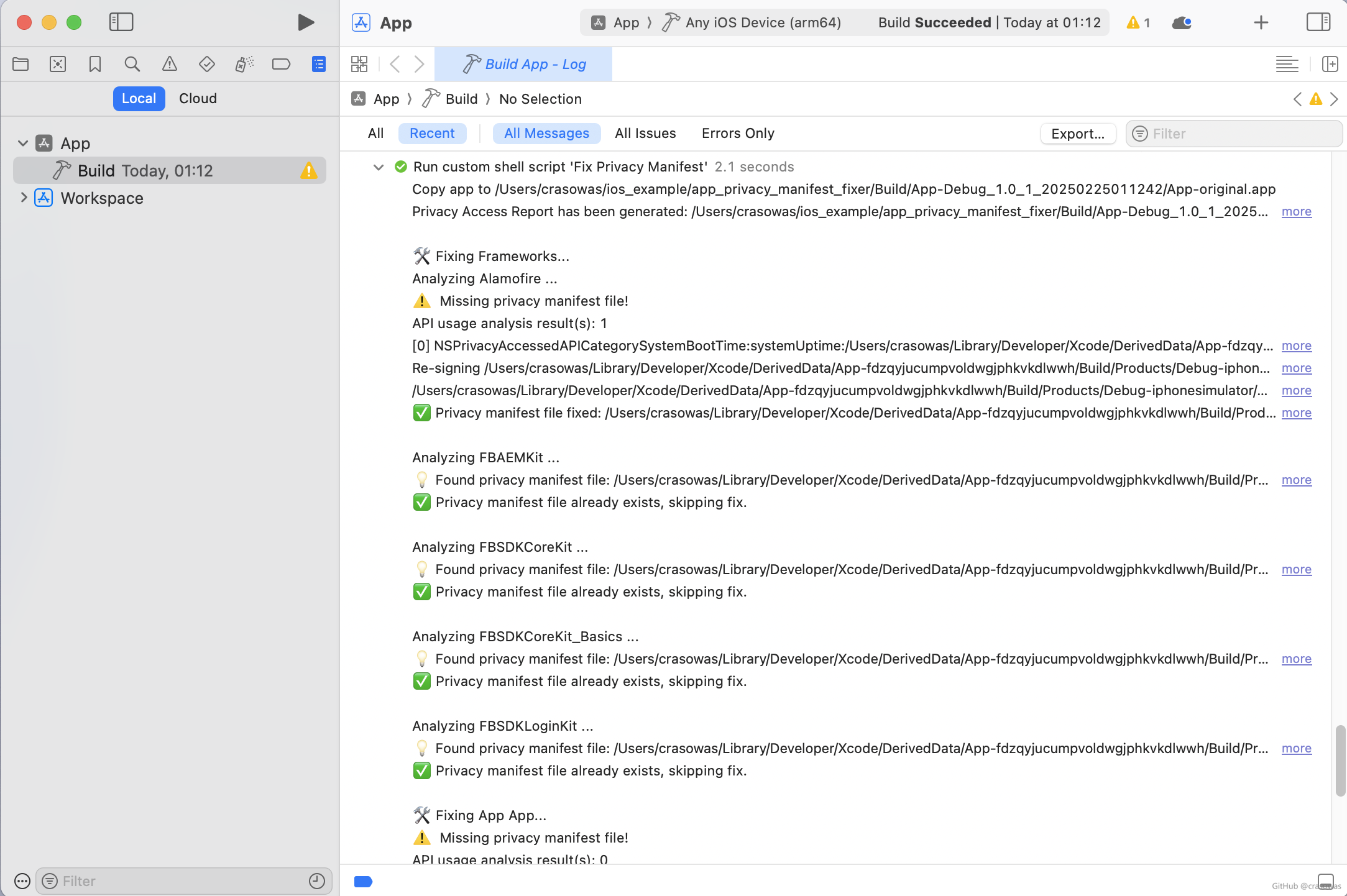English | 简体中文
This tool is an automation solution based on Shell scripts, designed to analyze and fix the privacy manifest of iOS apps to ensure compliance with App Store requirements. It leverages the App Store Privacy Manifest Analyzer to analyze API usage within the app and its dependencies, and generate or fix the PrivacyInfo.xcprivacy file.
- Non-Intrusive Integration: No need to modify the source code or adjust the project structure.
- Fast Installation and Uninstallation: Quickly install or uninstall the tool with a single command.
- Automatic Analysis and Fixes: Automatically analyzes API usage and fixes privacy manifest issues during the project build.
- Flexible Template Customization: Supports custom privacy manifest templates for apps and frameworks, accommodating various usage scenarios.
- Privacy Access Report: Automatically generates a report displaying the
NSPrivacyAccessedAPITypesdeclarations for the app and SDKs. - Effortless Version Upgrades: Provides an upgrade script for quick updates to the latest version.
- Download the latest release.
- Extract the downloaded file:
- The extracted directory is usually named
app_privacy_manifest_fixer-xxx(wherexxxis the version number). - It is recommended to rename it to
app_privacy_manifest_fixeror use the full directory name in subsequent paths. - It is advised to move the directory to your iOS project to avoid path-related issues on different devices, and to easily customize the privacy manifest template for each project.
- The extracted directory is usually named
-
Navigate to the tool's directory:
cd /path/to/app_privacy_manifest_fixer -
Run the installation script:
sh install.sh <project_path>
- For Flutter projects,
project_pathshould be the path to theiosdirectory within the Flutter project. - If the installation command is run again, the tool will first remove any existing installation (if present). To modify command-line options, simply rerun the installation command without the need to uninstall first.
- For Flutter projects,
If you prefer not to use the installation script, you can manually add the Fix Privacy Manifest task to the Xcode Build Phases. Follow these steps:
-
Open your iOS project in Xcode, go to the TARGETS tab, and select your app target.
-
Navigate to Build Phases, click the + button, and select New Run Script Phase.
-
Rename the newly created Run Script to
Fix Privacy Manifest. -
In the Shell script box, add the following code:
# Use relative path (recommended): if `app_privacy_manifest_fixer` is within the project directory "$PROJECT_DIR/path/to/app_privacy_manifest_fixer/fixer.sh" # Use absolute path: if `app_privacy_manifest_fixer` is outside the project directory # "/absolute/path/to/app_privacy_manifest_fixer/fixer.sh"
Modify
path/toorabsolute/path/toas needed, and ensure the paths are correct. Remove or comment out the unused lines accordingly.
Move this script after all other Build Phases to ensure the privacy manifest is fixed after all resource copying and build tasks are completed.
Below is a screenshot of the Xcode Build Phases configuration after successful automatic/manual installation (with no command-line options enabled):
After installation, the tool will automatically run with each project build, and the resulting application bundle will include the fixes.
If the --install-builds-only command-line option is enabled during installation, the tool will only run during the installation of the build.
Below is a screenshot of the log output from the tool during the project build (by default, it will be saved to the app_privacy_manifest_fixer/Build directory, unless the -s command-line option is enabled):
-
Force overwrite existing privacy manifest (Not recommended):
sh install.sh <project_path> -f
Enabling the
-foption will force the tool to generate a new privacy manifest based on the API usage analysis and privacy manifest template, overwriting the existing privacy manifest. By default (without-f), the tool only fixes missing privacy manifests. -
Silent mode:
sh install.sh <project_path> -s
Enabling the
-soption disables output during the fix process. The tool will no longer copy the generated*.app, automatically generate the privacy access report, or output the fix logs. By default (without-s), these outputs are stored in theapp_privacy_manifest_fixer/Builddirectory. -
Run only during installation builds (Recommended):
sh install.sh <project_path> --install-builds-only
Enabling the
--install-builds-onlyoption makes the tool run only during installation builds (such as the Archive operation), optimizing build performance for daily development. If you manually installed, this option is ineffective, and you need to manually check the For install builds only option.Note: If the iOS project is built in a development environment (where the generated app contains
*.debug.dylibfiles), the tool's API usage analysis results may be inaccurate.
To update to the latest version, run the following command:
sh upgrade.shTo quickly uninstall the tool, use the following command:
sh uninstall.sh <project_path>The privacy manifest templates are stored in the Templates directory, with the default templates already included in the root directory.
How can you customize the privacy manifests for apps or SDKs? Simply use custom templates!
The templates are categorized as follows:
- AppTemplate.xcprivacy: A privacy manifest template for the app.
- FrameworkTemplate.xcprivacy: A generic privacy manifest template for frameworks.
- FrameworkName.xcprivacy: A privacy manifest template for a specific framework, available only in the
Templates/UserTemplatesdirectory.
For an app, the priority of privacy manifest templates is as follows:
Templates/UserTemplates/AppTemplate.xcprivacy>Templates/AppTemplate.xcprivacy
For a specific framework, the priority of privacy manifest templates is as follows:
Templates/UserTemplates/FrameworkName.xcprivacy>Templates/UserTemplates/FrameworkTemplate.xcprivacy>Templates/FrameworkTemplate.xcprivacy
The default templates are located in the Templates root directory and currently include the following templates:
Templates/AppTemplate.xcprivacyTemplates/FrameworkTemplate.xcprivacy
These templates will be modified based on the API usage analysis results, especially the NSPrivacyAccessedAPIType entries, to generate new privacy manifests for fixes, ensuring compliance with App Store requirements.
If adjustments to the privacy manifest template are needed, such as in the following scenarios, avoid directly modifying the default templates. Instead, use a custom template. If a custom template with the same name exists, it will take precedence over the default template for fixes.
- Generating a non-compliant privacy manifest due to inaccurate API usage analysis.
- Modifying the reason declared in the template.
- Adding declarations for collected data.
The privacy access API categories and their associated declared reasons in AppTemplate.xcprivacy are listed below:
| NSPrivacyAccessedAPIType | NSPrivacyAccessedAPITypeReasons |
|---|---|
| NSPrivacyAccessedAPICategoryFileTimestamp | C617.1: Inside app or group container |
| NSPrivacyAccessedAPICategorySystemBootTime | 35F9.1: Measure time on-device |
| NSPrivacyAccessedAPICategoryDiskSpace | E174.1: Write or delete file on-device |
| NSPrivacyAccessedAPICategoryActiveKeyboards | 54BD.1: Customize UI on-device |
| NSPrivacyAccessedAPICategoryUserDefaults | CA92.1: Access info from same app |
The privacy access API categories and their associated declared reasons in FrameworkTemplate.xcprivacy are listed below:
| NSPrivacyAccessedAPIType | NSPrivacyAccessedAPITypeReasons |
|---|---|
| NSPrivacyAccessedAPICategoryFileTimestamp | 0A2A.1: 3rd-party SDK wrapper on-device |
| NSPrivacyAccessedAPICategorySystemBootTime | 35F9.1: Measure time on-device |
| NSPrivacyAccessedAPICategoryDiskSpace | E174.1: Write or delete file on-device |
| NSPrivacyAccessedAPICategoryActiveKeyboards | 54BD.1: Customize UI on-device |
| NSPrivacyAccessedAPICategoryUserDefaults | C56D.1: 3rd-party SDK wrapper on-device |
To create custom templates, place them in the Templates/UserTemplates directory with the following structure:
Templates/UserTemplates/AppTemplate.xcprivacyTemplates/UserTemplates/FrameworkTemplate.xcprivacyTemplates/UserTemplates/FrameworkName.xcprivacy
Among these templates, only FrameworkTemplate.xcprivacy will be modified based on the API usage analysis results to adjust the NSPrivacyAccessedAPIType entries, thereby generating a new privacy manifest for framework fixes. The other templates will remain unchanged and will be directly used for fixes.
Important Notes:
- The template for a specific framework must follow the naming convention
FrameworkName.xcprivacy, whereFrameworkNameshould match the name of the framework. For example, the template forFlutter.frameworkshould be namedFlutter.xcprivacy. - The name of an SDK may not exactly match the name of the framework. To determine the correct framework name, check the
Frameworksdirectory in the application bundle after building the project.
By default, the tool automatically generates privacy access reports for both the original and fixed versions of the app during each project build, and stores the reports in the app_privacy_manifest_fixer/Build directory.
If you need to manually generate a privacy access report for a specific app, run the following command:
sh Report/report.sh <app_path> <report_output_path>
# <app_path>: Path to the app (e.g., /path/to/App.app)
# <report_output_path>: Path to save the report file (e.g., /path/to/report.html)Note: The report generated by the tool currently only includes the privacy access section (NSPrivacyAccessedAPITypes). To view the data collection section (NSPrivacyCollectedDataTypes), please use Xcode to generate the PrivacyReport.
| Original App Report (report-original.html) | Fixed App Report (report.html) |
|---|---|
 |
 |
- If the latest version of the SDK supports a privacy manifest, please upgrade as soon as possible to avoid unnecessary risks.
- This tool is a temporary solution and should not replace proper SDK management practices.
- Before submitting your app for review, ensure that the privacy manifest fix complies with the latest App Store requirements.
Contributions in any form are welcome, including code optimizations, bug fixes, documentation improvements, and more. Please follow the project's guidelines and maintain a consistent coding style. Thank you for your support!



